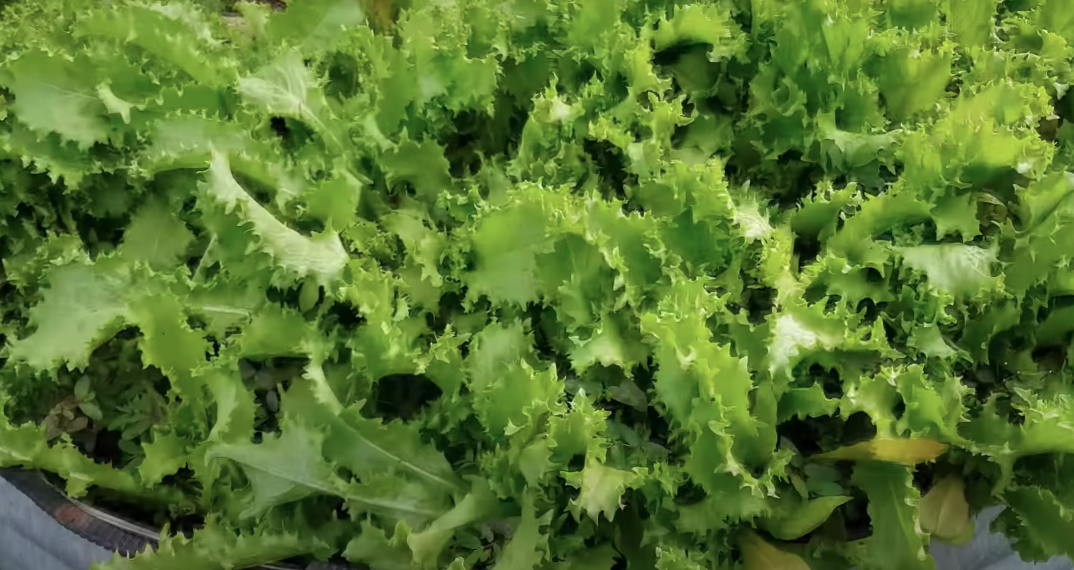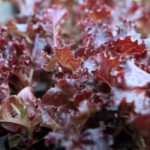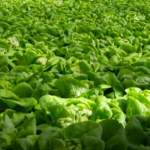Frisee lettuce (also frisée) is an endive vegetable variety with curly, loose frizzly looking leaves. It has a creamy yellowish center that is surrounded by green bitter outer leaves. The inner yellowish heart of the vegetable is often used in salads and other recipe preparations. Although referred to as a lettuce, botanically speaking, frisee lettuce does not share in the same genus nor family as Lactuca sativa, the regular lettuce that many are accustomed to. Frisee is sometimes interchangeably referred to as curly endive, curly leaf endive or curly chicory.
Table of Contents
What is Frisee Lettuce?
Frisee Lettuce Vs Escarole
As earlier mentioned, Frisee lettuce (also frisée) is an endive cultivar entirely different and of a separate group from the more common green or purple loose-leaf lettuce. The scientific name of frisee endive is Cichorium endivia var. crispum. Although there has been some confusion, this is different from Cichorium endivia var. latifolium which is escarole.
According to North Carolina State University Extension, frisee lettuce (var. crispum) and escarole (var. latifolium) are same species of chicory with shared characteristics such as rosette leaves and loose heads. These similarities between the cultivars may explain the continued interchangeability between curly endive and escarole in everyday use.
Frisee lettuce or curly endive has narrower looking curly leaves which are bitter dark green and a loose head which is creamy yellowish. On the other hand, escarole exudes broad, flat looking smooth leaves which are less bitter and a creamy yellow center. Both varieties have a yellowish loose head and can be sold as leafy greens.
Blonde Frisee
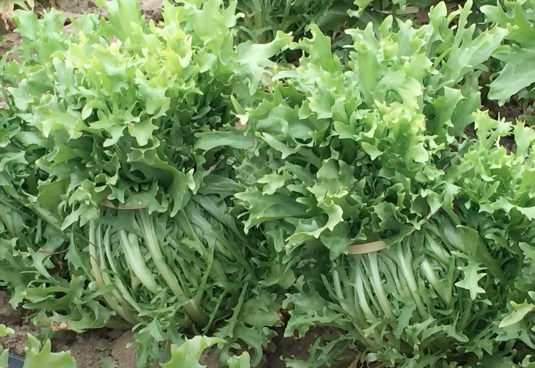
Blonde frisee is a specialty produce. It is a grower-created frisee lettuce product (not variety) involving the removal of the outer bitter green leaves of the curly endive. Blonde frisee is prepared in the field 7 to 10 days prior to harvest.
The endive plant starts out as a regular frisee with dark green leaves. Growers use rubber bands to tie the outer green leaves of the frisee together, wrapping them around the head as shown here. An alternative approach is to cover the heads with a container to block light. This shields the inner creamy yellow head from sunlight.
This method is also known as blanching. According to North Carolina State University Extension, blanching slows down the production of chlorophyll which is the reason for the bitter flavor. Any blanching or tying of frisee lettuce over the head must not be done on wet plants to avoid rotting.
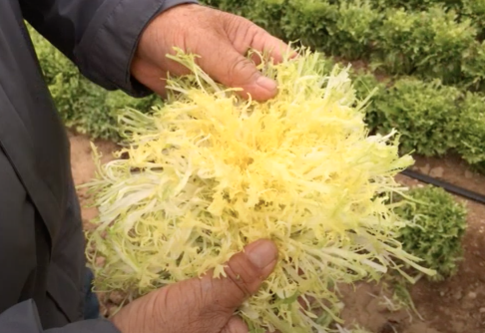
At harvest, several days later, the green outer leaves are removed exposing the inner creamy looking blonde frisee which is sold or consumed as specialty produce.
Blonde frisee lettuce is popular among specialty chefs who seem enchanted by its taste, tender leaves and looks. While blonde frisee lettuce has the outer leaves removed, the removed leaves are still edible and can also be used in recipes (see recipes section)
Frisee Lettuce Nutrition and Benefits
Questions have been asked, is frisee Lettuce good for you? Fact is, curly endive is one of the best sources of dietary Vitamin K-1. Vitamin K-1 is a type of Vitamin K. According to Healthline, a 100g of endives has as much as 231mcg of Vitamin K-1.
Vitamin K is needed by the human body for blood clotting, healthy heart and healthy bones. Although frisee lettuce represents one of its best sources, Vitamin K is available in a wide range of green vegetables. For this reason, it is difficult for the average person to be deficient in Vitamin K.
According to Dr Oz of the popular Dr Oz Show, frisee lettuce is beneficial in reducing the risk of ovarian cancer. This benefit is apparently attributed to kaempferol, a flavonoid found in endives. According to the Nutrition and Cancer journal, curly endive ranks among the top 10 major dietary sources of kaempferol at 10.10mg per 100g of edible portion. Raw Kale tops the list at 46.80mg.
Dr Oz’s claim is, however, downplayed by the journal which unambiguously states that “no association with ovarian cancer risk was observed for other vegetables that actually provide more kaempferol per serving than endive“.
The point the journal makes here is that other vegetables such as kale with greater kaempferol content have not shown this ovarian cancer benefit which brings into question Dr Oz’s claim which is based on a vegetable i.e. frisee endive with an even much lower kaempferol level.
Nonetheless, other scientific studies have established a beneficial link between kaempferol as found in leafy green sources such as frisee lettuce and incidences of cancer in general. For example, an article which appeared in 2013 in the Food Chemistry journal stated that kaempferol caused the death of cancer cells and also stops cancer cells from growing and multiplying. In this case, the benefit appears to have been associated with cancer in general and not specifically ovarian cancer as proposed by Dr Oz.
Yet another potential but little talked about benefit of eating frisee lettuce riding on the presence of kaempferol as found in the vegetable, is protection from disease of the human central nervous system (CNS). A research article which appeared in early 2021 in the journal Frontiers in Pharmacology highlighted the strong potential kaempferol possesses in addressing CNS related diseases. Well known CNS diseases and disorders include Parkinson’s disease, Cerebral palsy, Epilepsy and Multiple sclerosis.
Overall, it can be stated that frisee lettuce nutritional and other health benefits are not limited nor unique to this particular vegetable alone. It is apparent that the benefits derived from eating frisee lettuce can also be generally gained from regular consumption of a wide range of other readily available leafy greens. All things considered, frisee lettuce is therefore one of the many leading sources of kaempferol.
Frisee Lettuce Recipes
Curly endive is grown for food. It follows that the primary application of frisee is culinary in nature in a variety of recipe preparations. It has also been asked, is frisee lettuce bitter? Flavor wise, frisee can be described as mildly bitter, peppery with tender crunchy leaves. Considering that human palettes differ and are thus subjective, this is a general guide. Nonetheless, some of what to do with frisee lettuce includes raw salads, sautéing with common herbs such as garlic and basil, making sandwiches, and pairing with fruit.
How to prepare frisee lettuce
Depending on what you would want to achieve, we found two main ways to prepare frisee.
Blond-like frisee lettuce
This method follows the more traditional way of preparing frisee where the outer green leaves which are bitter are removed. This can be done using a good knife by shaving off the outer leaves until the center creamy yellow heart is exposed.
Bare hands can then come in to pick off any apparently remaining green leaves after using the knife. After this preparation exercise, what remains is essentially blonde frisee lettuce as discussed earlier.
After removing the outer leaves the frisee is washed before use in recipes. We recommend using a lettuce spinner for this purpose which does an effective job in both washing and drying the lettuce. Alternatively, after washing, the frisee lettuce would need to be paper towel dried before use to promote salad dressing adherence to the leaves.
We recommend this video which shows this blonde method step-by-step.
Wholly Sliced Frisee
This method results in a wholly sliced frisee lettuce head including the bitter green leaves and inner creamy yellow loose head. Unlike the forgoing method, this approach assumes everything will be consumed.
However, before anything else is done, the frisee head is first washed and spin dried using a salad spinner.
The outer leaves of the frisee are then gathered by hand wrapping them around the head. A knife is used to cut small bite size cuts of about an inch in size until the whole head is sliced up. To be noted is that the frisee is intentionally cut into small pieces to make it easier to eat when used in recipes.
Once sliced like this, if not being used immediately, the frisee can be stored in a bowel until it is ready to use in recipes.
We also recommend this short video which demonstrates this method.
Frisee Lettuce Recipes
It has been asked, how do you eat frisee lettuce? Frisee is mostly eaten raw in salads, but can also be sautéed and/or combined with fruit and with other warm or hot ingredients. The following are some scrumptious recipes that use frisee leafy greens, demonstrating “more than a thousand ways” to eat and enjoy frisee.
Frisee Salad With Poached Egg Recipe
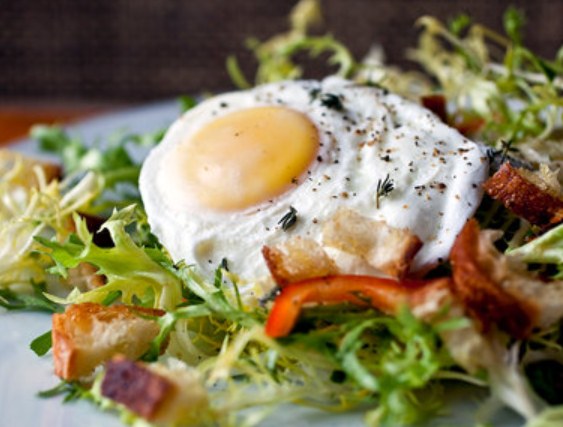
This is an originally French recipe which takes only 4 minutes to make. Instead of including bacon (which you may still do if you so wish), the recipe uses egg only. 2 frisee lettuce heads will make it into this recipe. Only the inner lighter looking leaves of the lettuce will be used discarding the strongly bitter outer leaves.
Before all this, the lettuce will need some washing and drying using a spinner. Other ingredients will be red pepper (you could also use pimentos here), eggs, fresh thyme leaves, baguette and vinegar among others. You could also use purple lettuce exclusively or together with frisee in this recipe. View Recipe.
Sautéed Frisee Lettuce Mushroom Salad Recipe
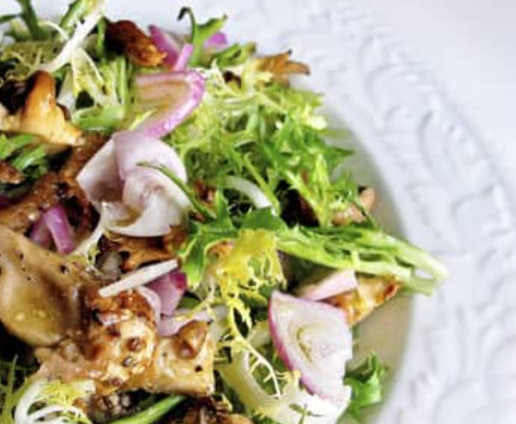
Sautéing frisee is an effective way to soften the crunch and free up some flavor. This recipe uses this approach. The total time for the recipe is 14 minutes which will produce a warm salad that pairs well with fish or seafood. Apart from the curly endive, the recipe will also use extra virgin olive oil, garlic, red pepper flakes, and oyster mushrooms.
Garlic and pepper flakes are added to the olive oil and pan fried for a short while before the rest of the ingredients follow. View Recipe.
Frisee Salad with Dijon Dressing Recipe
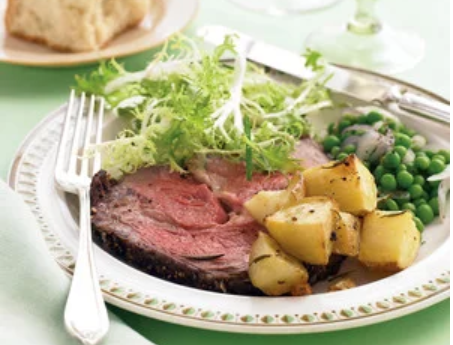
This recipe which has no heat involved, produces a quick and easy to make side dish in 20 minutes. It has two parts, the Dijon vinaigrette and then the salad. The first step is to make the salad dressing by combining, among other things, vinegar and mustard which are then blended.
The last step is to place hand torn frisee and chives in a bowl before combining with the vinaigrette. The scrumptious salad serves 8. View Recipe.
Cucumber Frisee Salad with Strawberries Recipe
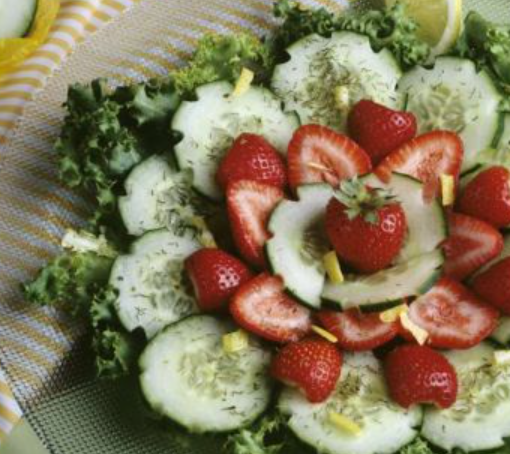
This recipe takes a uniquely different approach by combining fruit and vegetable i.e. strawberries, frisee lettuce and cucumber. There are options to the burpless cucumber for this recipe. You could use Armenian, Lemon, English or Persian cucumbers, all of which fit perfectly into this recipe.
Other ingredients which go into this simple 20 minute recipe are white vinegar, olive oil, salt and pepper. View Recipe.
Frisee Lettuce Salad with Hot Bacon Dressing Recipe
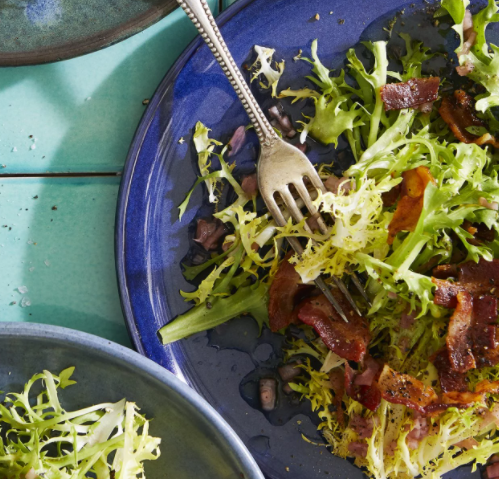
This recipe produces a salad in 15 minutes which combines a tad bit bitter frisee with a sweet and tangy hot bacon dressing to create a very interesting dish to the palette. The recipe will require a single head of frisee which is spinned and dried. Furthermore, the lettuce is torn by hand into pieces.
Other ingredients will be extra virgin olive oil, white vinegar, apple cider vinegar, red wine and sugar. Once ready, the hot bacon dressing will be poured over the frisee in a bowl and tossed to coat. View Recipe.
Peach Frisee Salad with Goat Cheese & Basil Recipe
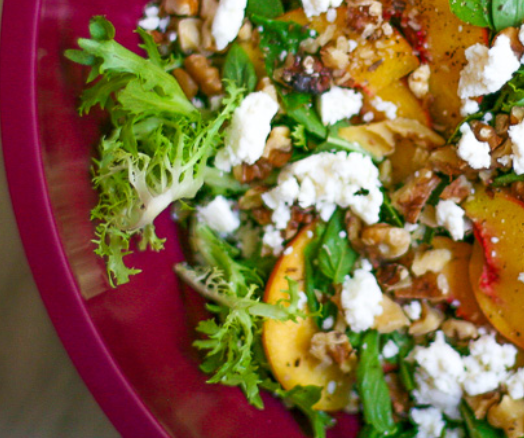
This is yet another frisee recipe which interestingly combines frisee with fruit. The herb in use in this recipe is basil. This presents an opportunity to also go beyond just the regular green basil and experiment with purple basil and even basil flowers in this recipe.
Two frisee heads that are hand torn will be required along with extra virgin olive oil, macadamia nuts and goat cheese as some of the ingredients highlights. This recipe is ready in 15 minutes and will serve 4. View Recipe.
Frisee Lettuce Seeds
An effective way to keep a fresh supply of curly endive going is by getting your own seeds for planting. Endive seeds are widely accessible. The bonus here being that the plant itself is easy to cultivate. Some growers have described curly chicory as easy as plant-and-forget when growing it (see growing section). The following is a list of frisee seed suppliers in North America.
- Endive “Green Ruffec” Frisee Heirloom Seeds via Amazon
- Endive Seeds by West Coast Seeds
- Frisee Endive Seeds by Baker Creek
- Endive Organic Seeds by Johnny’s Seeds
- Frisee Endive Seeds by Hudson Valley
- Heirloom Frisee Seeds by Eden Brothers
- Frisee Lettuce Seeds by True Leaf Market
How to Grow Frisee
If you can grow regular lettuce in pots or ground you can grow endive. Frisee is easy to grow and within the cultivation reach of many home growers. The wide accessibility of seed has also encouraged home growing of frisee. Curly endive is a biennial plant which is however grown as an annual plant.
Frisee Lettuce Season
Endive, just like regular lettuce, is a cool season or cool weather crop. Although frisee can tolerate higher temperatures than Lactuca sativa lettuce, optimum temperatures for best growing conditions are between 60°F and 65°F or 15°C and18°C. In hot weather, the plant will do with some partial shade.
Planting Frisee from Seed
Curly endive is propagated from seed some 4-6 weeks before the last day of frost. The seeds are planted directly into the ground at 0.25 inches or 0.64 cm deep in rows which are 18 inches or 46 cm apart. After germination which occurs at between 5 to 7 days after seeding, the crop is thinned for space only retaining the healthy ones. The optimal germination temperature of frisee lettuce seeds is 75°F or 24°C.
The best soils to grow endive are well drained sandy loam/silt or clay soils which are kept moist.
Frisee Care and Maintenance
Frisee lettuce is generally a low maintenance crop in the home garden but can be high maintenance in a commercial setting. The lettuce should be kept well-watered to avoid dryness. Drought will induce bolting. To retain moisture in the soil, use plastic, grass or leaves as mulch. This also works as an effective method of suppressing weeds. If blanching, as earlier mentioned, this should be done several days before harvest to dry crop to reduce risk of rotting
The main pests to be concerned about are aphids, slugs and snails. In a homestead setting, deer and rabbits enjoy this lettuce and can compete with the grower to harvest the lettuce.
Although straightforward to grow, there is more to appreciate about growing curly endives. We highly recommend this guide by The Royal Horticultural Society of the UK. Considering frisee lettuce has been cultivated in Europe since the 16th century, much earlier than the United States (19th century), this can be considered a useful resource from the horse’s mouth!
Conclusion
Frisee lettuce is an endive cultivar with curly, loose frizzly looking leaves. Although often confused with escarole, frisee lettuce is not exactly escarole despite the fact that the two share some similarities. In addition, frisee is also not the same as the more common regular green lettuce. The leafy green is often used raw as specialty produce that is applied in wide ranging variations of salads.
There are identifiable human health and nutritional benefits associated with eating endives. However, for the most part, these benefits can also be derived from eating a wide variety of other leafy greens. Finally, frisee lettuce is easy to grow and requires similar conditions as those for growing regular lettuce. The lettuce is grown from seed which is widely available. This is one of the reasons it is becoming trendy with home growers.
Random But Good Reads:
